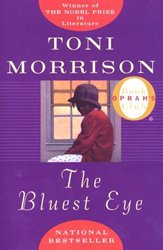Trauma and World Literature: The Bluest Eye by Toni Morrison
Howard Lipke, PhD
September 29, 2022

Twenty-three years after publication of her classic novel, The Bluest Eye, Toni Morrison wrote in an afterword that the primary mission of her book (if I understand her correctly) was to resolve a question. That question was: How could her African American schoolgirl friend not have experienced the beauty that she already possessed and have wished for blue eyes, with the implicit “racial self-loathing” of that wish? Morrison wonders, “Who made her feel that it was better to be a freak than what she was?” (Morrison, 1970, p. 210). In her afterword, Morrison recounts that the book was initially not generally well-received. Thankfully, it has since been recognized for its superb literary and social value. This is not just in that it answers Morrison’s initial question, but also in that it provides the kind of insights into human experience as a whole—and in this case, especially social and racial relations—that are the special province of great literature.
The passage below is set in Morrison’s hometown of Lorain, Ohio, in the early 1940s. Early in the story, Morrisons’s hero, Picola Breedlove, a little girl who is the survivor and ultimately victim of unspeakable mistreatment, arrives at a local shop with her three pennies.
“Mr. Yacobowski, the store owner, looks toward her. Somewhere between retina and object, between vision and view, his eyes draw back, hesitate, and hover. At some fixed point in time and space he senses that he need not waste the effort of a glance. He does not see her, because for him there is nothing to see. How can a fifty-two-year-old white immigrant store keeper with the taste of potatoes and beer in his mouth, his mind honed on the doe-eyed Virgin Mary, his sensibilities blunted by a permanent awareness of loss, see a little black girl? Nothing in his life even suggested that the feat was possible, not to say desirable or necessary.
’Yeah?’
“She looks up at him and sees the vacuum where curiosity ought to lodge. And something more. The total absence of human recognition – the glazed separateness. She does not know what keeps his glance suspended. Perhaps because he is grown, or a man, and she is little girl. But she has seen interest, disgust, even anger in grown male eyes. Yet this vacuum is not new to her. It has an edge; somewhere in the bottom lid is the distaste. She has seen it lurking in the eyes of all white people. So. The distaste must be for her, her blackness. All things in her are flux and anticipation. But her blackness is static and dread. And it is the blackness that accounts for, that creates, the vacuum edged with distaste in white eyes.
“She points her finger at the Mary Janes – a little black shaft of a finger, its tip pressed on the display window. The quietly inoffensive assertion of a black child’s attempt to communicate with a white adult.
’Them.’ The word is more sigh than sense.
’What? These? These?’ Phlegm and impatience mingle in his voice.
“She shakes her head, her fingertips fixed on the spot which, in her view, at any rate, identifies the Mary Janes. He cannot see her view – the slant of her finger, makes it incomprehensible to him. His lumpy red hand plops around the glass casing like the agitated head of a chicken outraged by the loss of its body.
’Christ. Kantcha talk?’
His fingers brush the Mary Janes.
She nods.
’Well, whyn’t you say so? One? How many?’
“Pecola unfolds her fist, showing the three pennies. He scoots three Mary Janes toward her – three yellow rectangles in each packet. She holds the money toward him. He hesitates, not wanting to touch her hand. She does not know how to move the finger of her right hand from the display counter or how to get the coins out of her left hand. Finally he reaches over and takes the pennies from her hand. His nails graze her damp palm.
“Outside, Pecola feels the inexplicable shame ebb.
“Dandelions. A dart of affection leaps out from her to them. But they do not look at her and do not send love back. She thinks, ‘They are ugly. They are weeds.’ Preoccupied by that revelation, she trips on the sidewalk crack. Anger stirs and wakes in her; it opens its mouth, and like a hot-mouthed puppy, laps up the dredges of her shame.
“Anger is better. There is a sense of being in anger. A reality and presence. An awareness of worth. It is a lovely surging. Her thoughts fall back to Mr. Yacobowski’s eyes, his phlegmy voice. The anger will not hold; the puppy is too easily surfeited. Its thirst too quickly quenched, it sleeps. The shame wells up again, its muddy rivulets seep into her eyes. What to do before the tears come. She remembers the Mary Janes.
“Each pale yellow wrapper has a picture on it. A picture of little Mary Jane, for whom the candy is named. Smiling white face. Blond hair in gentle disarray, blue eyes looking at her out of a world of clean comfort. The eyes are petulant, mischievous. To Pecola they are simply pretty. She eats the candy, and its sweetness is good. To eat the candy is to somehow eat the eyes, eat Mary Jane. Love Mary Jane. Be Mary Jane.” (Morrison, 1970, pp. 48 – 50)
Morrison, Toni. (1970; afterword, 1993). The Bluest Eye. New York: Plume.